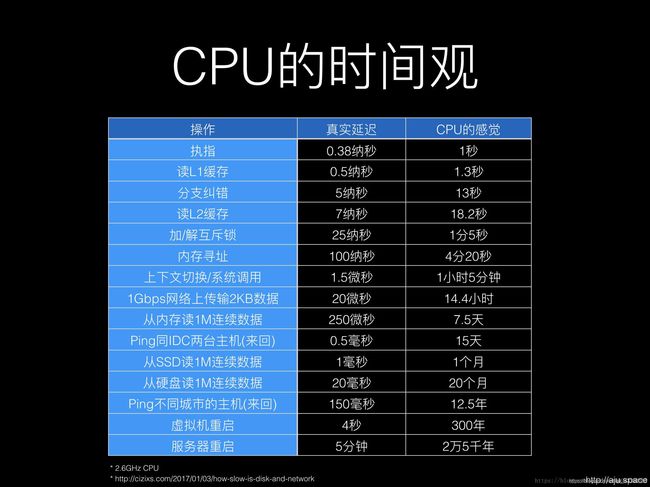Python 异步 async/await(进阶详解)
文章目录
- CPU的时间观
- I/O(异步的瓶颈)
- 基础概念
-
- 进程/线程
- 阻塞/非阻塞
- 并发/并行
-
- CPU调度策略
- 同步/异步
- 事件循环+回调
- 协程(异步)
- async/await
-
- asyncio事件循环(python3.6)
- asyncio事件循环(python3.7)
- async
- await
- asyncio.create_task()
- asyncio.futures对象
- 实例
- 参考
介绍异步前,先简述几个计算中有意思的概念。
CPU的时间观
如果电脑的主频为2.6G,也就是每秒可以执行2.6*10^9个指令,每个指令只需要0.38ns。
假设一个指令时间比作人类能够感知的一秒钟来对比数据,如下图:
(借用一张网络download的CPU时间观的对比图)
举个常见的例子
1Gbps网络上传输2KB数据,真实延迟20微秒,CPU感觉过了14.4小时!!!
- CPU是计算机的核心,如果利用率低,不仅浪费资源,而且程序执行效率低下,需要耗费更长的时间(这是最应该关注的点)
- 如果不提高程序执行效率,等同于“谋财害命”
I/O(异步的瓶颈)
- CPU的时间观中可以看出除了
执行指令和一级缓存,对CPU来说是可接受的,其他操作都很慢很慢很慢很慢很慢很慢(特别是从上下文切换开始)!!!- 回顾一下大学期间,被老师强调无数次的的
冯·诺依曼结构- 数学家冯·诺依曼提出了计算机制造的三个基本原则,即采用二进制逻辑、程序存储执行以及计算机由五个部分组成(运算器、控制器、存储器、输入设备、输出设备),这套理论被称为冯·诺依曼体系结构。
- 从冯·诺依曼体系结构得出,运算器和控制器主要集成在CPU上的,其余全是I/O,包括磁盘读写,网卡读写等等。
- 异步可以提高程序效率,但是I/O依旧是最大的瓶颈!
- 因此I/O是程序效率的最大瓶颈!!!!!
- 因此I/O是程序效率的最大瓶颈!!!!!
- 因此I/O是程序效率的最大瓶颈!!!!!
(没有卡,重要的事情说三遍!)- 世界上最大的计算机程序,莫过于因特网,因此网络I/O(CPU的时间观)成为了I/O的最大瓶颈!
- 除了宕机,网络I/O是最慢的 最慢的 最慢的!因此诸多异步框架基本都是处理网络I/O的。
- 后面介绍
使用协程去处理异步程序,尽可能的利用I/0操作时的等待时间去执行其他动作,提高程序执行效率。
基础概念
如果基础概念已经了解,请直接跳过本节。
进程/线程
- 进程(Process)是计算机中的程序关于某数据集合上的一次运行活动,是系统进行资源分配和调度的基本单位,是操作系统结构的基础。在早期面向进程设计的计算机结构中,进程是程序的基本执行实体;在当代面向线程设计的计算机结构中,进程是线程的容器。程序是指令、数据及其组织形式的描述,进程是程序的实体。
- 线程(thread)是操作系统能够进行运算调度的最小单位。它被包含在进程之中,是进程中的实际运作单位。一条线程指的是进程中一个单一顺序的控制流,一个进程中可以并发多个线程,每条线程并行执行不同的任务。在Unix System V及SunOS中也被称为轻量进程(lightweight processes),但轻量进程更多指内核线程(kernel thread),而把用户线程(user thread)称为线程。
- 一个进程可以有很多线程,每条线程并行执行不同的任务。
阻塞/非阻塞
- 阻塞和非阻塞指的是调用者(程序)在等待返回结果(或输入)时的状态。
- 阻塞时,在调用结果返回前,当前线程会被挂起,并在得到结果之后返回。
- 非阻塞时,如果不能立刻得到结果,则该调用者不会阻塞当前线程。因此对应非阻塞的情况,调用者需要定时轮询查看处理状态。
并发/并行
- 并发:在操作系统中,是指一个时间段中有几个程序都处于已启动运行到运行完毕之间,且这几个程序都是在同一个处理机上运行,但任一个时刻点上只有一个程序在处理机上运行。
- 并行:在操作系统中是指,
一组程序按独立异步的速度执行,无论从微观还是宏观,程序都是一起执行的。- 对比地讲,并发是:
在同一个时间段内,两个或多个程序执行,有时间上的重叠(宏观上是同时,微观上仍是顺序执行)。
CPU调度策略
- 在并发运行中,CPU需要在多个程序之间来回切换,因此会有一些切换的调度策略。
- 先来先服务 - 时间片轮转调度
- 优先级调度
- 最短作业优先
- 最高响应比优先
- 多级反馈队列调度
同步/异步
- 同步:在发出一个同步调用时,在没有得到结果之前,该调用就不返回。
- 异步:在发出一个异步调用后,调用者不会立刻得到结果,该调用就返回了。
- 同步和阻塞的定义很像,但却是两个概念,同步不一定阻塞,在结果没有返回前,阻塞是指线程被挂起,这段程序不再执行,而同步调用是在运行状态,CPU还在执行这段程序。
- 异步和非阻塞定义也很像,但也是两个概念,异步指在调用时不会立即得到结果,调用就返回了,线程可能阻塞,也可能不阻塞。而非阻塞是指调用的时候,线程一定不会进入非阻塞状态。
事件循环+回调
- 所谓的事件循环,并非是一个真正意义上的循环,可以理解为一种定义,可以理解为是主线程不断的从事件队列里面取值/函数的过程,因为这一过程是不断发生的所以我们为了方便把这个过程叫事件循环。
- 事件本身并没有循环的,循环的只是主线程取事件的动作。
软件模块之间总是存在着一定的接口,从调用方式上,可以把他们分为三类:同步调用、回调和异步调用。- 同步调用是一种阻塞式调用,调用方要等待对方执行完毕才返回,它是一种单向调用;
- 回调是一种双向调用模式,也就是说,被调用方在接口被调用时也会调用对方的接口;
- 异步调用是一种类似消息或事件的机制,不过它的调用方向刚好相反,接口的服务在收到某种讯息或发生某种事件时,会主动通知客户方(即调用客户方的接口)。
- 回调和异步调用的关系非常紧密,通常我们使用回调来实现异步消息的注册,通过异步调用来实现消息的通知。
协程(异步)
python中为了提高I/O效率,使用协程去处理异步程序,协程自动完善了上述的各种调度任务!
至于如何完善的,在之后的文章中会详述。(也可能会鸽了)
-
进程和线程是计算机提供的,协程是程序员创造的,不存在于计算机中。
-
协程(Co-routine),也可称为微线程,或非抢占式的多任务子例程,一种用户态的上下文切换技术(通过一个线程实现代码块间的相互切换执行)
-
意义:在一个线程(协程)中,遇到io等待时间,线程可以利用这个等待时间去做其他事情。
async/await
asyncio事件循环(python3.6)
- 事件循环:去检索一个任务列表的所有任务,并执行所有未执行任务,直至所有任务执行完成。
- 执行协程函数,必须使用事件循环。
# python 源码
import asyncio
async def func1():
print('协程1')
async def func2():
print('协程2')
# task可为列表,即任务列表
# task = func1()
task = [func1(), func2()]
# 创建事件循环
loop = asyncio.get_event_loop()
# 添加任务,直至所有任务执行完成
loop.run_until_complete(asyncio.wait(task))
#关闭事件循环
loop.close()
# 事件循环关闭后,再次调用loop,将不会再次执行。
asyncio事件循环(python3.7)
- python3.7省略的手动创建事件循环,可直接用
asyncio.run()去执行协程任务。
import asyncio
async def func1():
print('协程1')
async def func2():
print('协程2')
task = [func1(), func2()]
# python3.7引入的新特性,不用手动创建事件循环
asyncio.run(task)
async
- 协程函数:定义函数时加上async修饰,即
async def func() - 协程对象:执行
协程函数得到的对象
注:执行协程函数得到协程对象,函数内部代码不会执行
# python 源码
>>> import asyncio
>>> async def main():
... print('hello')
... await asyncio.sleep(1)
... print('world')
>>> main()
<coroutine object main at 0x1053bb7c8>
>>> asyncio.run(main())
hello
world
- 执行协程函数内部代码,必须把协程对象交给
事件循环处理
await
- await + 可等待对象(协程对象,Future,Task对象(IO等待))
等待到对象的返回结果,才会继续执行后续代码
# python 源码
import asyncio
import time
async def say_after(delay, what):
await asyncio.sleep(delay)
print(what)
async def main():
print(f"started at {time.strftime('%X')}")
await say_after(1, 'hello')
#await say_after(1, 'hello')执行完之后,才继续向下执行
await say_after(2, 'world')
print(f"finished at {time.strftime('%X')}")
asyncio.run(main())
output:
started at 17:13:52
hello
world
finished at 17:13:55
asyncio.create_task()
asyncio.create_task()作为异步并发运行协程的函数Tasks。- 将协程添加到
asyncio.create_task()中,则该协程将很快的自动计划运行
# python 源码
async def main():
task1 = asyncio.create_task(
say_after(1, 'hello'))
task2 = asyncio.create_task(
say_after(2, 'world'))
print(f"started at {time.strftime('%X')}")
# Wait until both tasks are completed (should take around 2 seconds.)
# 两个任务同时执行,直到到所有任务执行完成。
await task1
await task2
print(f"finished at {time.strftime('%X')}")
output:
started at 17:14:32
hello
world
finished at 17:14:34
注:比不使用
asyncio.create_task()的结果快了一秒,也即两个任务同时执行了。
asyncio.futures对象
- 官方文档对Future的介绍如下
Futures
A Future is a special low-level awaitable object that represents an eventual result of an asynchronous operation.
When a Future object is awaited it means that the coroutine will wait until the Future is resolved in some other place.
Future objects in asyncio are needed to allow callback-based code to be used with async/await.
Normally there is no need to create Future objects at the application level code.
Future objects, sometimes exposed by libraries and some asyncio APIs, can be awaited:
大概意思是:
Future是特殊的低级等待对象,代表异步操作的最终结果。
当等待Future对象时,它意味着协程将等待,直到在其他地方解析Future。
需要在asyncio中使用将来的对象,以允许将基于回调的代码与async / await一起使用。
通常,不需要在应用程序级别的代码中创建Future对象。
- 使用async/await时 会自动创建Future对象。(在此作为了解即可)
实例
- 正常的网络请求
# python 源码
import requests
import time
def result(url):
res = request_url(url)
print(url,res)
def request_url(url):
res = requests.get(url)
print("\n",res)
time.sleep(2)
print("execute_time:",time.time()-start)
return res
url_list = ["https://www.csdn.net/",
"https://blog.csdn.net/qq_43380180/article/details/111573642",
"https://www.baidu.com/",
]
start = time.time()
print("start_time:",start)
task = [result(url) for url in url_list]
endtime = time.time()-start
print("\nendtime:",time.time())
print("all_execute_time:",endtime)
output:
start_time: 1608888064.4879584
execute_time: 4.062316656112671
https://www.csdn.net/
execute_time: 6.691046237945557
https://blog.csdn.net/qq_43380180/article/details/111573642
execute_time: 9.305423259735107
https://www.baidu.com/
endtime: 1608888073.7933817
all_execute_time: 9.305423259735107
3个网络请求耗时9.3秒
- 使用协程
# python 源码
import asyncio
import requests
import time
async def result(url):
res = await request_url(url)
print(url, res)
async def request_url(url):
res = requests.get(url)
print(url)
await asyncio.sleep(2)
print("execute_time:", time.time() - start)
return res
url_list = ["https://www.csdn.net/",
"https://blog.csdn.net/qq_43380180/article/details/111573642",
"https://www.baidu.com/",
]
start = time.time()
print(f"start_time:{start}\n")
task = [result(url) for url in url_list]
loop = asyncio.get_event_loop()
loop.run_until_complete(asyncio.wait(task))
endtime = time.time() - start
print("\nendtime:", time.time())
print("all_execute_time:", endtime)
output:
start_time:1608887916.4435036
https://blog.csdn.net/qq_43380180/article/details/111573642
https://www.baidu.com/
https://www.csdn.net/
execute_time: 2.6272454261779785
https://blog.csdn.net/qq_43380180/article/details/111573642
execute_time: 3.0642037391662598
https://www.baidu.com/
execute_time: 3.9802708625793457
https://www.csdn.net/
endtime: 1608887920.4237745
all_execute_time: 3.9802708625793457
使用协程耗时3.9秒
对比结果可以看出,协程大大提高了程序的执行效率,程序数量越多,越能体现出协程对程序的执行效率越高!!!!
注:使用协程时,需要其底层方法实现时就是协程,才会生效,否则协程不生效!
- 此处使用的
requests底层实现并不是异步,因此使用了time.sleep()和asyncio.sleep()模拟放大网络IO时间。 - 异步模块举例:aiohttp-requests、aiofiles、grequests等
文章中有不足或错误的地方,欢迎留言指正!
参考
-
协程和任务:
https://docs.python.org/3.7/library/asyncio-task.html -
深入理解python异步
https://mp.weixin.qq.com/s?__biz=MzIxMjY5NTE0MA==&mid=2247483720&idx=1&sn=f016c06ddd17765fd50b705fed64429c -
Python异步编程 asyncio小白速通
https://www.bilibili.com/video/BV1dD4y127bD?from=search&seid=15383041802813101586
